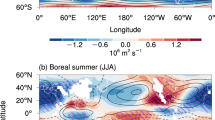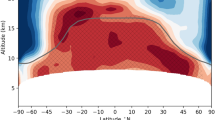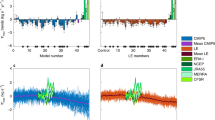Abstract
Arising from: Q. Fu et al. Nature 429, 55–58 (2004); see also communication from Tett et al.; Fu et al. reply Satellite observations of tropospheric temperatures seem to show less warming than surface temperatures, contrary to physical predictions1. Fu et al.2 show that statistical correction for the effect of stratospheric cooling brings the satellite-based estimates of tropospheric warming into closer agreement with observations of surface warming. Here we apply the method of Fu et al.2 to output from a state-of-the-art coupled climate model and show that simulated tropospheric temperature trends are consistent with those observed and that their method is robust.
Similar content being viewed by others
Main
Tropospheric temperatures (T2) monitored by channel 2 of the satellite-based Microwave Sounding Unit (MSU) include a contribution from temperatures in the cooling stratosphere1,2 (T4). Using radiosonde data, Fu et al.2 apply a regression method to quantify the relative influences of T4 and T2 on the mean temperature of the 850–300-hPa layer (T850–300). We apply the Fu et al. regression method to simulated 1958–97 monthly-mean global-mean T4, T2 and T850–300 from a four-member ensemble of a climate-change experiment that was performed with the National Center for Atmospheric Research Parallel Climate Model (PCM)3,4 with combined anthropogenic and natural forcing.
The model-derived regression coefficients of T850–300 against T2 and T4 are a2=1.106±0.026 and a4=−0.157±0.019, with 5–95% uncertainty ranges derived from intra-ensemble variability. Results are in close agreement with the coefficients estimated by Fu et al.2 from radiosonde data (a2=1.156, a4=−0.153). To assess the contribution to these coefficients of the overlap between the T2 and T4 weighting functions, we derive a weighting function for T850–300 and regress this directly against the mass-based weighting functions5 of T2 and T4. This yields a2=1.089 and a4=−0.129, implying that the regression relation derived by Fu et al. arises largely from the overlap of the weighting functions, rather than from physical coupling between tropospheric and stratospheric temperatures.
Because we know the actual T850–300 trends over 1979–99 in PCM, we can evaluate the reliability of the statistical method of Fu et al.2 for reconstructing these trends. For each ensemble member, trend reconstructions were produced with the Fu et al. and PCM-derived regression coefficients. Reconstructed trends agree with the actual PCM T850–300 trends to within 0.016 K per decade on average (Fig. 1). We find a similar level of agreement between PCM's reconstructed and actual T850–300 trends for the Northern and Southern Hemispheres and the tropics. Note that although simulated trends in T2LT (where T2LT is a synthetic channel for lower-middle troposphere) and T850–300 are in close correspondence, PCM's T2LT trends are not subject to problems that affect the observed T2LT product, such as changes in surface emissivity, intersatellite calibration biases, and noise amplification2.
Black crosses, trends in T850–300 over the period 1979–99, as simulated by the National Center for Atmospheric Research Parallel Climate Model (PCM) in each of four realizations of an experiment with anthropogenic and natural forcing3,4. Asterisks indicate free-tropospheric temperature trends reconstructed from synthetic T2 and T4 trends using the method of Fu et al.2. These are calculated using three different sets of regression coefficients, which are derived from radiosonde observations by Fu et al.2 (pink asterisks), estimated from the PCM experiments (dark blue asterisks), and obtained directly from the T2 and T4 weighting functions (light blue asterisks). Red crosses, simulated trends in T2; green crosses, simulated trends in T2LT. The simulated trend in T4 is −0.36±0.03 K per decade. The model's surface warming over 1890–1999 (0.62 °C) is consistent with that observed.
Our model-based T850–300 trends shown in Fig. 1 are consistent with the free tropospheric temperature trends that Fu et al. reconstructed from MSU observations for the period 1979–2001 (refs 2, 6; 0.09 and 0.18 K per decade for the UAH (University of Alabama at Huntsville) and RSS (Remote Sensing Systems) reconstructions, respectively). Overall, we find that the analysis method of Fu et al.2 is robust, and that their radiosonde-based regression relationships between T4, T2 and T850–300 are in good agreement with those independently derived from climate-model output.
References
National Research Council Reconciling Observations of Global Temperature Change (National Academy, Washington DC, 2000).
Fu, Q., Johanson, C. M., Warren, S. G. & Seidel, D. J. Nature 429, 55–58 (2004).
Santer, B. D. et al. Science 301, 479–483 (2003).
Washington, W. M. et al. Clim. Dyn. 16, 755–774 (2000).
Spencer, R. W. & Christy, J. R. J. Clim. 5, 847–857 (1992).
Santer, B. D. et al. J. Geophys. Res. 109, doi:10.1029/2004JD005075 (2004).
Author information
Authors and Affiliations
Corresponding author
Additional information
Reply: Fu et al. reply to this communication (doi:10.1038/nature03210).
Rights and permissions
About this article
Cite this article
Gillett, N., Santer, B. & Weaver, A. Stratospheric cooling and the troposphere. Nature 432, 1 (2004). https://doi.org/10.1038/nature03209
Published:
Issue Date:
DOI: https://doi.org/10.1038/nature03209
This article is cited by
-
Causes of differences in model and satellite tropospheric warming rates
Nature Geoscience (2017)
-
Tropospheric Warming Over The Past Two Decades
Scientific Reports (2017)
-
Global warming: a review of this mostly settled issue
Stochastic Environmental Research and Risk Assessment (2009)
-
Stratospheric cooling and the troposphere (reply)
Nature (2004)
Comments
By submitting a comment you agree to abide by our Terms and Community Guidelines. If you find something abusive or that does not comply with our terms or guidelines please flag it as inappropriate.




